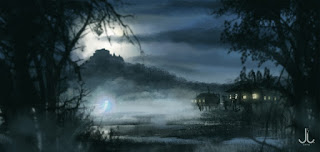Traditional media, 2
Paintings given as Christmas gifts. Still working on photographing my work - bloody mess when you're not much of a photo guy, like me - but it's improving.
Formats are 40×50cm illustration board with canvas texture, 24×30 twice, and 25×30cm stretched canvases, respectively. Mediums used were acrylic paints, gel pens, pigmented ink pens, coloured pencils, structure paste, and Indian ink.
Formats are 40×50cm illustration board with canvas texture, 24×30 twice, and 25×30cm stretched canvases, respectively. Mediums used were acrylic paints, gel pens, pigmented ink pens, coloured pencils, structure paste, and Indian ink.







It's been many years since I attempted a painting, so I've not had the need to try to photograph one, but I've been keeping these blog posts in my back pocket in case that day ever comes. Maybe they'll help you.
ReplyDeletehttp://muddycolors.blogspot.com/2012/12/how-to-photograph-your-paintings.html
http://muddycolors.blogspot.com/2013/07/how-to-professionally-photograph-your.html
Thanks! I actually follow the Muddycolors blog, but only recently started taking an interest in the posts specific to traditional media and probably missed a whole lot. It's quite satisfying though, to work with traditional media again - even if I'm really bad at wet-stretching, it seems - and I find I experiment more freely.
DeleteStrangely, while being very figurative in digital, I tend to more abstracted depictions when using physical media. But I tried doing the same with digital, and liked it a lot. Being still quite unsure about what my perfect way of painting is, that's a strong clue.
I wonder if there's something about digital that leads to thinking more analytically, since you can so easily tweak and perfect things. The permanence of many physical media (or at least the increased effort it takes to make corrections compared to clicking "undo") could lead to a paralyzing need to get everything right the first time, or it could lead to more freedom to experiment and embrace happy accidents since you probably won't be getting it perfect anyway.
DeleteFor me, it's usually more about barriers to entry: Picking up pencil and paper to draw is easier than opening up Photoshop and creating a new document, but that's easier than getting painting supplies out. So most of my drawing happens traditionally, but when I want to experiment with color I tend to start with digital.
Muddy Colors is great. I love that they cover such a range of topics. Even the ones that don't really apply to me (like the industry stuff, since I'm not a professional) are still interesting to read. You never know where you're going to find new insights or inspirations.
I don't know if there is a perfect way of painting. That's why it's so nice to try out different things and see what you like.
I often see the opposite of analytical thinking in digital, exactly because you can tweak everything. Traditional paintings require some planning, on format if nothing else. For the better, I think - considering issues beforehand helps the painting. Unless you're one of those painters who can come up with something worthwhile without any plan.
DeleteYes, having no materials on hand is often a hindrance to start. Watercolour pencils with a water brush have become a wonderful alternative to brushwork for me, especially on the go.
I enjoy exactly those imperfections of traditional media, the tiny variations in colour and ever-so-slightly irregular edges - things that cause much work on the digital canvas. And you're right there's no perfect way, but there may be a perfect way for one person - but then, I hear so many artists restoring my calm by admitting they do things differently every time, it seems that's perfectly normal.